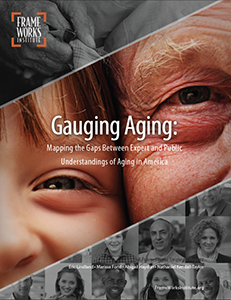In 2014, eight of the nation’s leading aging-focused organizations, including the AGS, formed an unprecedented partnership, the Leaders of Aging Organizations (LAO), to create a better public understanding of older adults’ needs and contributions to society—and subsequently to improve health and care for us all as we age.
In April 2019, the AGS signed on as a partner in the Reframing Aging Initiative, the next, long-term phase of the LAO-founded movement. Coordinated by the Gerontological Society of America (GSA) and funded by The John A. Hartford Foundation, the Archstone Foundation, the RRF Foundation for Aging, and The SCAN Foundation, Reframing Aging offers AGS access to new tools and training opportunities as we continue to advocate for changes in public discourse on age.
Learn More About Reframing in Action
A new lecture series produced by the FrameWorks Institute in collaboration with the Leaders of Aging Organizations and Grantmakers in Aging gives you a guided tour of how to use new, evidence-based framing strategies to communicate more powerfully about aging as a social policy issue.
Sharpen your skills by accessing these free video lectures today!
Advancing Research
Through anthropological studies and social science research conducted with our partner, the FrameWorks Institute, the LAO has uncovered how language (even down to specific word choices) can present a significant obstacle when conveying to the general public and policymakers the advances we have made in healthcare and aging services. Despite years of progress in our own understanding of aging as geriatrics healthcare professionals, for example, public perceptions are still mired in a “swamp” that treats aging as:
- Someone else's problem. People tend to focus on “the aged” as an otherized group.
- Undesirable. The public associates aging almost exclusively with decline and deterioration.
- An inescapable decline. For most, “fading away” is tied to a strong sense of inevitability around “breaking down” as a central aspect of growing old.
- Isolated. A majority of the public perceives old age not only as an outside obstacle, but also as a personal or familial problem, not a challenge that society shares.
- Fatalistic. Intimately tied to these perceptions are fears of decline, depression, and dependence. Such fears not only imbue aging with dread, but also impede support for policies and solutions that address the challenges (and opportunities) associated with age.
- Out of sight, out of mind. Fear and misperceptions ultimately fuel a lack of attention to older adult health, but keeping aging “off the radar” does little to remedy impediments to health as we grow older.
Reframing Aging
 Since the release of the LAO's first ground-breaking report, Gauging Aging, the AGS and other LAO partners have been working to develop and share resources on changes we can make—including but also beyond the choice of words we use to describe older adults—to frame geriatrics research in ways that resonate with the public. In partnership with the FrameWorks Institute, the LAO has released a collection of resources to help advocates drive a more-productive narrative about the benefits of an increase in the average lifespan. The FrameWorks Institute's empirical approach to developing and testing frames—suggestions for how to position messages about aging—yielded provocative insights and practical recommendations such as the following.
Since the release of the LAO's first ground-breaking report, Gauging Aging, the AGS and other LAO partners have been working to develop and share resources on changes we can make—including but also beyond the choice of words we use to describe older adults—to frame geriatrics research in ways that resonate with the public. In partnership with the FrameWorks Institute, the LAO has released a collection of resources to help advocates drive a more-productive narrative about the benefits of an increase in the average lifespan. The FrameWorks Institute's empirical approach to developing and testing frames—suggestions for how to position messages about aging—yielded provocative insights and practical recommendations such as the following.
- Aging needs to be redefined. Widespread negative assumptions about “getting old” have led the public to take a fatalistic stance that there is not much to be done about aging.
- A call for justice beats a plea for sympathy. A controlled experiment found that one of the most-effective ways to build support for greater inclusion of older people was a reminder that a just society strives to treat everyone as equal participants.
- A new metaphor dramatically shifts perceptions of aging. FrameWorks Institute researchers found that, by comparing the process of aging to building momentum, researchers as communicators can open a new way to thinking and talking about aging—something counter to currently available cultural idioms such as “fighting” aging or the importance of “staying young.” An innovative test of how messaging can affect people's implicit associations showed that this metaphor reduced ageist attitudes by a remarkable 30%.
For more information and to access the suite of free LAO-FrameWorks tools, click here.
The LAO coalition includes AARP, the American Federation for Aging Research, the AGS, the American Society on Aging, The Gerontological Society of America, Grantmakers in Aging, the National Council on Aging, n4a, and the National Hispanic Council on Aging. Funding for the initiative has been provided by AARP, Archstone Foundation, The Atlantic Philanthropies, Endowment for Health, Fan Fox and Leslie R. Samuels Foundation, The John A. Hartford Foundation, RRF Foundation for Aging, Next 50 Initiative, Tufts Health Plan Foundation, San Antonio Area Foundation, Rose Community Foundation, and The SCAN Foundation.
Collaboration in Action
In 2017, the Journal of the American Geriatrics Society (JAGS) adopted the American Medical Association (AMA) Manual of Style as its guide for manuscript submissions. As part of that transition, the AGS worked with the journal's editorial team to make important modifications to AMA guidance reflecting our work with the LAO and FrameWorks Institute and our efforts to shift the public conversation on aging and older adults. Since this change was announced, several other research journals have joined the movement, including Geriatric Nursing and the Journal of Gerontological Nursing. Learn more in this editorial co-authored by AGS CEO Nancy Lundebjerg, MPA, and Editor-in-Chief of JAGS, William B. Applegate, MD, MPH, AGSF.

